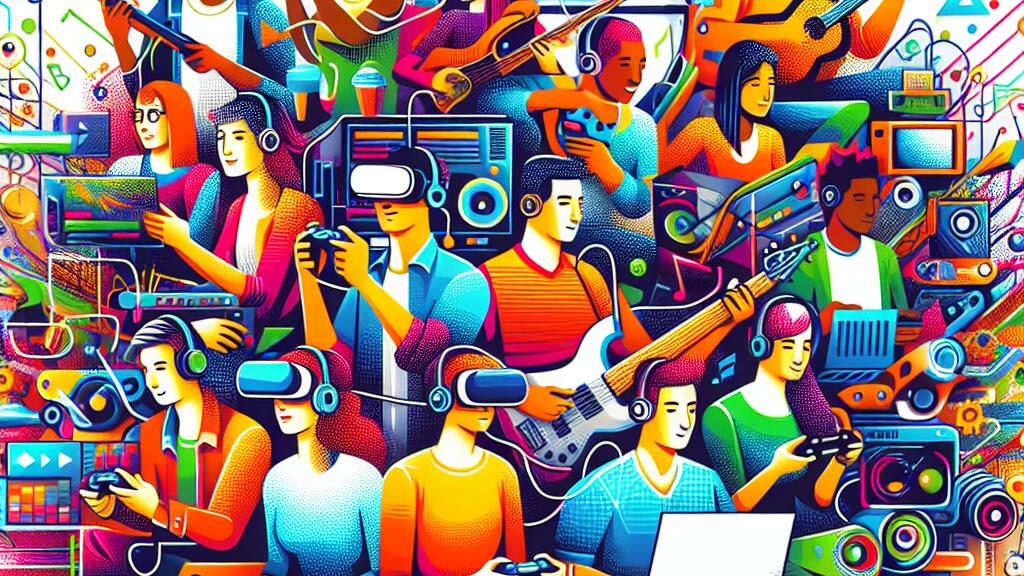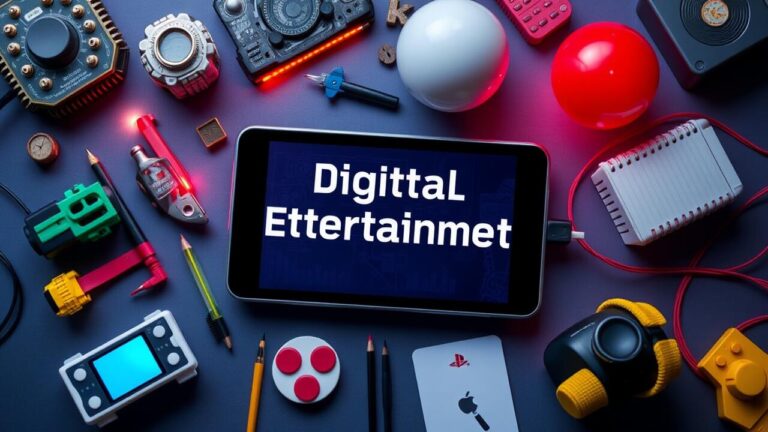Cloud gaming has burst onto the scene as a revolutionary force in the realm of digital entertainment, shaking up everything we thought we knew. Imagine this: users streaming video games straight from remote servers—no need for that beefy local hardware weighing down your setup! Heavyweights in the industry have thrown their weight behind this tech marvel, granting players access to vast libraries of games across an array of devices—be it consoles or smartphones. The sheer convenience and flexibility that cloud gaming offers are redefining how gamers dive into their beloved titles, breaking down barriers and opening doors for diverse audiences.
But wait, there’s more! The ascent of cloud gaming is not just about how we consume games; it’s a mirror reflecting the changing landscape of gamer expectations. With lightning-fast responsiveness and top-notch streaming capabilities, players revel in stunning graphics and immersive gameplay without those old-school hurdles. As internet infrastructure advances at breakneck speed and awareness around these services skyrockets, we’re on the cusp of a significant expansion in the cloud gaming market. This shifting tide brings both golden opportunities and intricate challenges for game developers and platform providers alike as they navigate an industry increasingly molded by connectivity and user-centric experiences.

Virtual Reality in Entertainment
The rise of virtual reality technologies has utterly revolutionized the realm of entertainment, crafting experiences so immersive that they effortlessly meld the digital with the physical. Picture this: a universe where gaming, cinema, and live events collide in spectacular fashion. With headsets snugly fitting on eager faces and motion-tracking gadgets capturing every nuance, creators whisk audiences away to intricately designed realms where interaction reigns supreme. Thanks to leaps in graphics and sound design, virtual reality doesn’t just elevate storytelling; it concocts wholly unique multisensory adventures.
This fusion of virtual reality into entertainment isn’t just a niche endeavor—it’s lured in an eclectic mix of fans, from die-hard tech aficionados to laid-back casual users dipping their toes into this brave new world. As barriers fall—both financial and technical—a broader swath of people is poised to dive into VR content like never before! Meanwhile, developers are boldly navigating uncharted narrative territories that exploit the very essence of these virtual spaces, birthing groundbreaking modes of expression within entertainment’s embrace. This transformation hints at a monumental shift in how we create and consume content—a trajectory destined to shape future modalities for years to come!
Innovative Experiences and Current Trends
In the ever-evolving realm of digital entertainment, we’re witnessing a seismic shift—one that pulses with innovation and bursts forth in vibrant user experiences, all fueled by cutting-edge technology. Gone are the days when audiences were mere spectators; now, they dive headfirst into interactive storytelling and choose-your-own-adventure narratives that pull them into the heart of the action. Picture this: gamification elements weaving their way through platforms like confetti at a parade, offering tantalizing rewards and achievements that not only prolong engagement but also forge tight-knit communities among viewers.
And then there’s the personalized touch—oh yes! Platforms are scrambling to serve up content tailored just for you, employing algorithms that dance gracefully around individual preferences and viewing habits. But wait! The excitement doesn’t stop there. A wave of emerging trends is sweeping across entertainment like wildfire, spotlighting an intense focus on immersive experiences. Virtual reality (VR) and augmented reality (AR) applications are no longer fringe concepts; they’re breaking ground in multiple sectors, dissolving boundaries between our digital fantasies and physical realities.
These groundbreaking technologies invite users to step inside stories from perspectives previously unimaginable—a mesmerizing journey indeed! Meanwhile, live streaming events—from electrifying concerts to nail-biting gaming tournaments—are igniting instantaneous connections among fans as if magic itself has woven them together in real-time camaraderie. As these exhilarating experiences continue to unfold before our very eyes, they’re not just reshaping how we consume content; they’re compelling creators and platforms alike to innovate relentlessly in this captivating landscape.
Trends in Digital Content Consumption
In a whirlwind of technological leaps and ever-changing consumer whims, the realm of digital content consumption has been turned upside down. Streaming services? They’ve skyrocketed in popularity, like a rocket ship blasting off into the stratosphere, while traditional cable subscriptions have taken a nosedive. Today’s viewers crave on-demand offerings that mold themselves around their busy lives, giving birth to the binge-watching phenomenon—an insatiable appetite for entire seasons devoured in one sitting.
But wait, there’s more! The rise of personalized algorithms is reshaping our viewing experiences; platforms are now crafting recommendations with uncanny precision that pulls us deeper into their captivating worlds. It’s not just about watching anymore—it’s an immersive adventure tailored to individual tastes!
Then there’s social media—a seismic force shaking up how we consume content. Users buzz about shows and movies across every conceivable platform, sharing opinions and sparking discussions like wildfire. And let’s not overlook short-form content; TikTok and Instagram have ignited a demand for bite-sized videos packed with instant allure—attention spans are shorter than ever! Consequently, savvy content creators are recalibrating their strategies to align with this fast-paced landscape, embracing interactive elements designed to hook viewers from the very first frame. Adaptation isn’t just necessary; it’s essential in this dynamic dance between technology and audience desire!
Shifts in Viewer Preferences and Demographics
Viewing habits are in the midst of a dramatic overhaul, as audiences increasingly flock toward personalized content options that cater to their unique tastes. Subscription-based models have surged in popularity, granting consumers an unprecedented level of choice and control over what they choose to watch—or not watch. This seismic shift towards on-demand services has fundamentally transformed the television landscape, pulling viewers away from conventional linear programming with a magnetic force. Particularly among younger demographics, there’s an unmistakable tilt toward streaming platforms that champion original content and experimental storytelling.
But wait—there’s more! The explosion of mobile devices has revolutionized not just how we consume content but also when and where we indulge in it. This tech-savvy generation leans heavily into short-form videos and interactive experiences rather than lengthy shows that seem to drag on forever. Social media platforms now wield significant influence over how people discover new content, further complicating viewer preferences and nudging audiences toward those non-traditional outlets. As these changes unfold at breakneck speed, content providers must scramble to adapt or risk losing touch with the ever-evolving demands of an audience that’s becoming increasingly segmented and diverse.
The Future of Digital Entertainment
Technological advancements are on the brink of revolutionizing the landscape of digital entertainment in ways we can hardly imagine. Picture this: artificial intelligence weaving its magic into content creation and distribution, crafting personalized viewing experiences that draw users in like moths to a flame, intensifying engagement levels beyond our wildest dreams. And let’s not forget about immersive technologies—augmented reality and virtual reality bursting onto the scene, conjuring entirely new realms of storytelling and interaction that challenge what we thought possible with conventional media.
As if that weren’t enough, consumer behaviors are shifting gears at breakneck speed—driven by factors like accessibility and the omnipresence of smart devices. Audiences crave an eclectic mix of on-demand content; platforms may very well pivot towards subscription-based models offering exclusive gems hidden behind paywalls. With an insatiable thirst for interactive experiences rising to fever pitch, content creators find themselves in a race against time to recalibrate their strategies. They must stay sharp and relevant amid an ever-evolving battleground where competition lurks around every corner!
Predictions and Emerging Technologies
In the not-so-distant future, a whirlwind of emerging technologies is set to transform the digital entertainment landscape in ways we can barely fathom. Picture this: artificial intelligence making its mark by crafting hyper-personalized content recommendations that draw users deeper into their viewing experiences, amplifying engagement and satisfaction like never before. But that’s just the tip of the iceberg!
Enter 5G technology—a game changer that promises to obliterate latency in streaming services. Imagine gliding through high-definition content without a hitch, even while on the move—it’s almost exhilarating to think about!
And hold onto your hats because we’re on the cusp of something monumental: augmented reality (AR) and virtual reality (VR) are creeping into mainstream entertainment with relentless momentum. These cutting-edge technologies will create immersive worlds where traditional viewing becomes a relic of the past; audiences won’t just watch—they’ll dive headfirst into intricate narratives, engaging in ways previously confined to dreams or sci-fi tales. As studios and platforms plunge into these thrilling digital enhancements, audience expectations will inevitably morph, craving bolder innovations in storytelling and content delivery that challenge our very perceptions of entertainment itself.
Regional Variations in Content Access
Access to digital entertainment platforms is a curious tapestry woven from the threads of culture, economy, and regulation—each influencing how we engage with content across the globe. In developed nations, where high-speed internet flows like a river, streaming and gaming become an effortless dance of pixels and sound. But flip the coin to developing countries, and you encounter a starkly different reality: limited infrastructure clashing with affordability constraints creates barriers that keep vast libraries just out of reach.
Language emerges as another formidable guardian at this gate; many international services fail to offer localized content, creating chasms in viewer engagement for those who don’t speak English fluently. Imagine scrolling through a sea of options only to find them wrapped in tongues unfamiliar—a disheartening experience indeed!
But wait—there’s more! Licensing deals twist the narrative further still. Major streaming giants often broker rights based on geography’s whims, leading to regional catalogs that can feel like night-and-day contrasts from one place to another. Picture this: you stumble upon your favorite show online only to discover it’s been locked away behind invisible borders—frustration bubbles up as you’re left yearning for what could have been.
To complicate matters even further are regulatory hurdles like censorship laws that slice through available offerings in certain countries with ruthless precision. These variances not only mold consumer habits but also reshape the very competitive landscape of digital entertainment itself—a vibrant yet fragmented mosaic reflecting our world today.
Licensing and Regulatory Challenges
Digital entertainment platforms find themselves ensnared in a labyrinth of licensing and regulatory hurdles that can dramatically influence their operational dynamics and the richness of content available. The global expanse of digital media only adds layers to this complexity, as varied copyright laws and regulations from one country to another often give rise to intricate, sometimes bewildering licensing agreements. These platforms are tasked with deciphering the maze of regional legislation while ensuring that content creators receive fair compensation—a process that can stretch negotiations into drawn-out battles or even ignite potential legal skirmishes.
But wait—there’s more! Beyond the murky waters of copyright, these platforms must grapple with consumer protection statutes, privacy mandates, and standards for content moderation. As governments across the globe roll out fresh legislation aimed at safeguarding user data and tackling harmful material head-on, digital entertainment providers are compelled to pivot swiftly. Ignoring such regulations? A perilous gamble—it could lead to hefty fines, restrictions on what they can show (or not), along with tarnishing their brand’s reputation beyond repair. Thus arises an urgent need for continuous dialogue among platform operators, creative minds behind the scenes, and regulatory authorities; all striving together—or perhaps just trying to get along—to cultivate a climate ripe for innovation while keeping consumer interests firmly in sight.
Content Creation and Distribution
Ah, the landscape of content creation and distribution! It’s a veritable whirlwind of change, ignited by the explosive rise of digital platforms. Independent creators—those bold pioneers—now wield an arsenal of tools and resources that empower them to conjure high-quality content, all without bending the knee to those monolithic studios of yore. This democratization is not merely a shift; it’s a seismic eruption enabling a kaleidoscope of voices and perspectives to burst forth into the limelight while nurturing an exhilarating culture brimming with innovation.
Now, consider this: streamlined distribution channels have flung open the doors to global audiences in mere moments, effortlessly bypassing those traditional gatekeepers who once held sway over what we could see and hear. The streaming services? Oh, they’re on a relentless march forward! The clamor for fresh, original content has reached fever pitch—a cacophony demanding attention. Major platforms are pouring vast sums into exclusive offerings like moths drawn to flames in their bid for subscribers, igniting fierce competition among creators.
In such an electrifying atmosphere, collaboration blossoms between conventional media giants and independent artists—a heady mix where established franchises tango with inventive originals. And let’s not forget about audience engagement—it has morphed into the lifeblood of savvy content strategies! Analytics now dance at the forefront, guiding future productions and marketing maneuvers as if orchestrating a grand symphony destined for success. What a time to be alive in this dizzying realm!
The Shift Towards Independent Productions
The digital entertainment landscape is undergoing a remarkable metamorphosis, as independent productions burst forth into the limelight. An ever-increasing throng of creators are harnessing the power of digital platforms to unveil their stories, deftly maneuvering around traditional barriers that once held sway over access to major studios. This evolution paves the way for fresh narratives and a kaleidoscope of viewpoints, cultivating an entertainment realm that embraces inclusivity like never before.
Moreover, technological innovations have democratized production tools, empowering independent filmmakers and content creators to craft high-quality masterpieces without breaking the bank. Audiences—hungry for something different—are irresistibly drawn toward the unique tales and avant-garde formats that these indie projects frequently deliver. As preferences shift and morph, viewers crave authenticity and originality; qualities that resonate deeply with the spirit of independent artistry.
The triumphs of various indie endeavors underscore not just artistic merit but also significant financial promise within this vibrant sector. The meteoric rise of streaming services has further revolutionized distribution methods, granting independent filmmakers unprecedented access to broader audiences while circumventing conventional routes altogether. This burgeoning trend signals a profound transformation in how content is created and consumed across the digital entertainment spectrum—a thrilling new chapter ripe with possibilities!
| Independent Production | Director | Year Released | Platform | Notable Achievements |
|---|---|---|---|---|
| Moonlight | Barry Jenkins | 2016 | A24 | Academy Award for Best Picture |
| The Florida Project | 2017 | A24 | Academy Award Nominee for Best Supporting Actor | |
| Lady Bird | Greta Gerwig | 2017 | A24 | Academy Award Nominee for Best Picture |
| Get Out | Jordan Peele | 2017 | Blumhouse Productions | Academy Award for Best Original Screenplay |
| Parasite | Bong Joon-ho | 2019 | CJ Entertainment | Academy Award for Best Picture |
The Impact of COVID-19
The COVID-19 pandemic unleashed a whirlwind of transformation in how consumers interacted with entertainment platforms, an upheaval that was nothing short of seismic. As physical gatherings were curtailed and social activities ground to a halt, audiences found themselves gravitating towards the digital realm for both engagement and escapism. Streaming services skyrocketed in popularity—viewers hungrily devoured films, series, and live events from the cozy confines of their homes. This sudden tidal wave of demand compelled these platforms to turbocharge their libraries, often placing original content and exclusive releases at the forefront to entice—and keep—their subscribers.
But wait! There’s more: the pandemic ignited a shift in platform usage habits that few could have predicted. Binge-watching emerged as a dominant pastime; screen time swelled like never before, upending traditional viewing rituals along the way. The explosion in viewer engagement sent content creators into a frenzy—a creative race against time to innovate at breakneck speed. Virtual events burst onto the scene: think live concerts streaming right into your living room or interactive experiences that drew viewers deeper into participation than ever before. This dramatic pivot has not just reshaped expectations but is poised to leave an indelible mark on content production and distribution strategies long after this global crisis recedes into memory.
Changes in Consumption Patterns and Platform Usage
The pandemic has drastically reshaped the landscape of how audiences dive into digital entertainment, creating a whirlwind of change. In-person events? Once bustling with energy, now they’ve seen attendance plummet, prompting viewers to flock toward streaming platforms, gaming realms, and virtual meet-ups like moths to a flame. This seismic shift ignited an insatiable hunger for on-demand content and sparked a revolution in personalized viewing experiences that cater directly to individual whims. Audiences have become savvy navigators of their own entertainment journeys, expertly curating schedules tailored to their tastes.
And let’s not overlook the explosion of mobile devices—oh, what a game changer! Smartphones and tablets are now our trusty sidekicks, granting us seamless access to an endless buffet of content at any moment we please. This evolution doesn’t just spotlight the need for adaptable platforms that can dance across different screen sizes; it also emphasizes the vital role of flexible content formats that keep pace with our ever-changing consumption habits. As digital entertainment hurtles forward into uncharted territory, grasping these shifting patterns is essential for creators and distributors aiming to stay relevant in this dynamic ecosystem.
- Increased reliance on streaming platforms for diverse content consumption.
- Rise in the popularity of mobile apps for on-the-go access to entertainment.
- Growth of virtual events as an alternative to traditional in-person gatherings.
- Surge in demand for personalized content recommendations and curated playlists.
- Emergence of interactive content formats, such as gaming and live streaming.
- Shift towards shorter content formats, accommodating busy lifestyles and attention spans.
- Expansion of subscription-based models reflecting consumer preference for on-demand access.
Conclusion
The realm of digital entertainment platforms is in a state of constant flux, propelled by lightning-fast technological breakthroughs and the ever-evolving tastes of consumers. Cloud gaming and virtual reality are not merely trends; they’re revolutionizing the very fabric of how content is delivered and experienced, conjuring up immersive worlds that ensnare audiences like never before. As viewers increasingly crave tailored and interactive forms of amusement, providers find themselves on a tightrope, needing to pivot swiftly to meet these insatiable demands if they wish to thrive in this whirlwind market.
But wait—there’s more! Emerging technologies dance intricately with regional disparities in content access, weaving a complex tapestry that makes managing digital licenses and regulations feel like navigating through a labyrinth. Meanwhile, the surge of independent productions signals an exciting shift in content creation—a vibrant mosaic showcasing diverse voices and perspectives that were once sidelined. For stakeholders wading through this tumultuous landscape marked by relentless innovation and heightened consumer engagement, grasping these trends isn’t just important; it’s absolutely vital for survival amidst the chaos!




